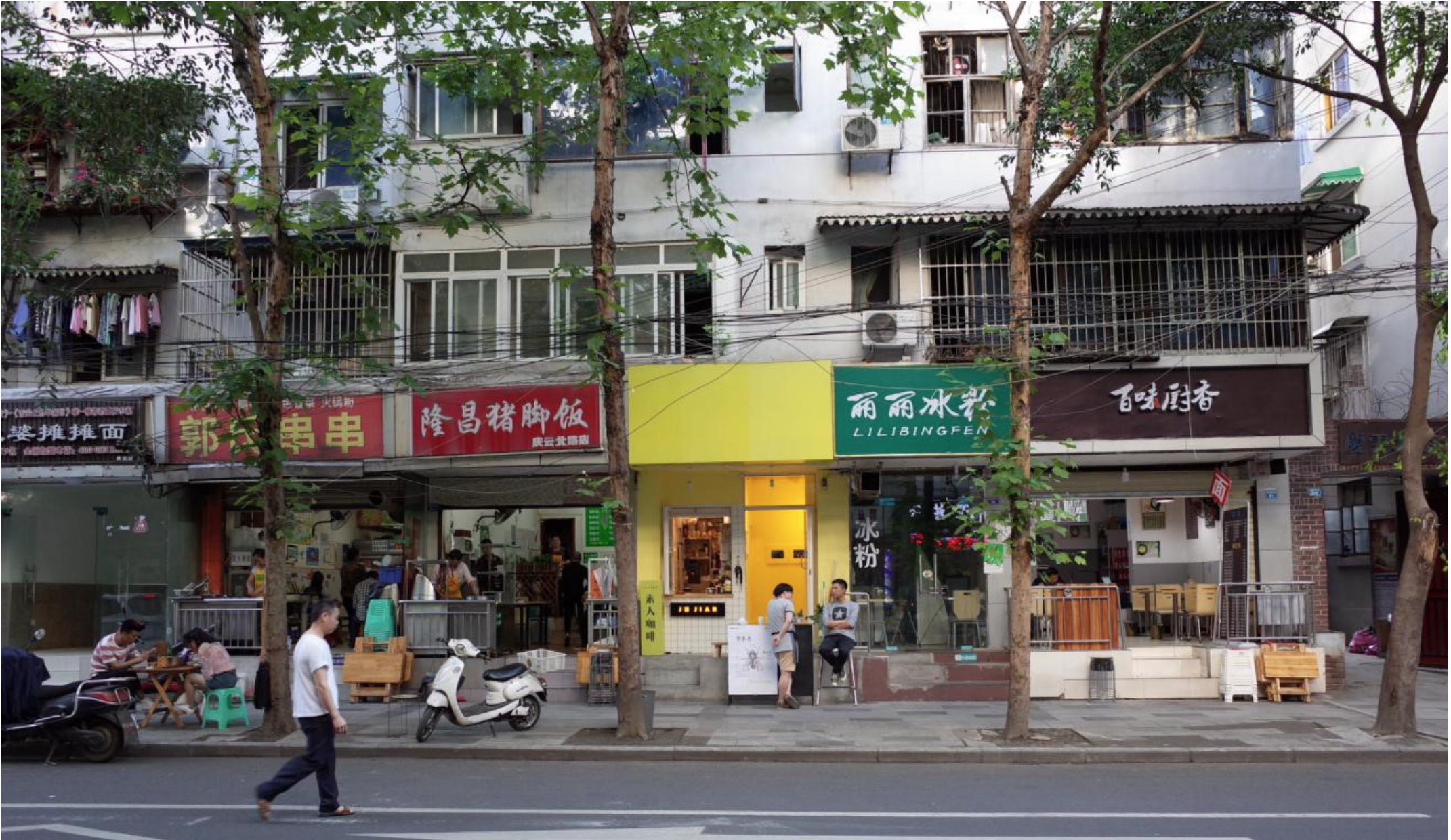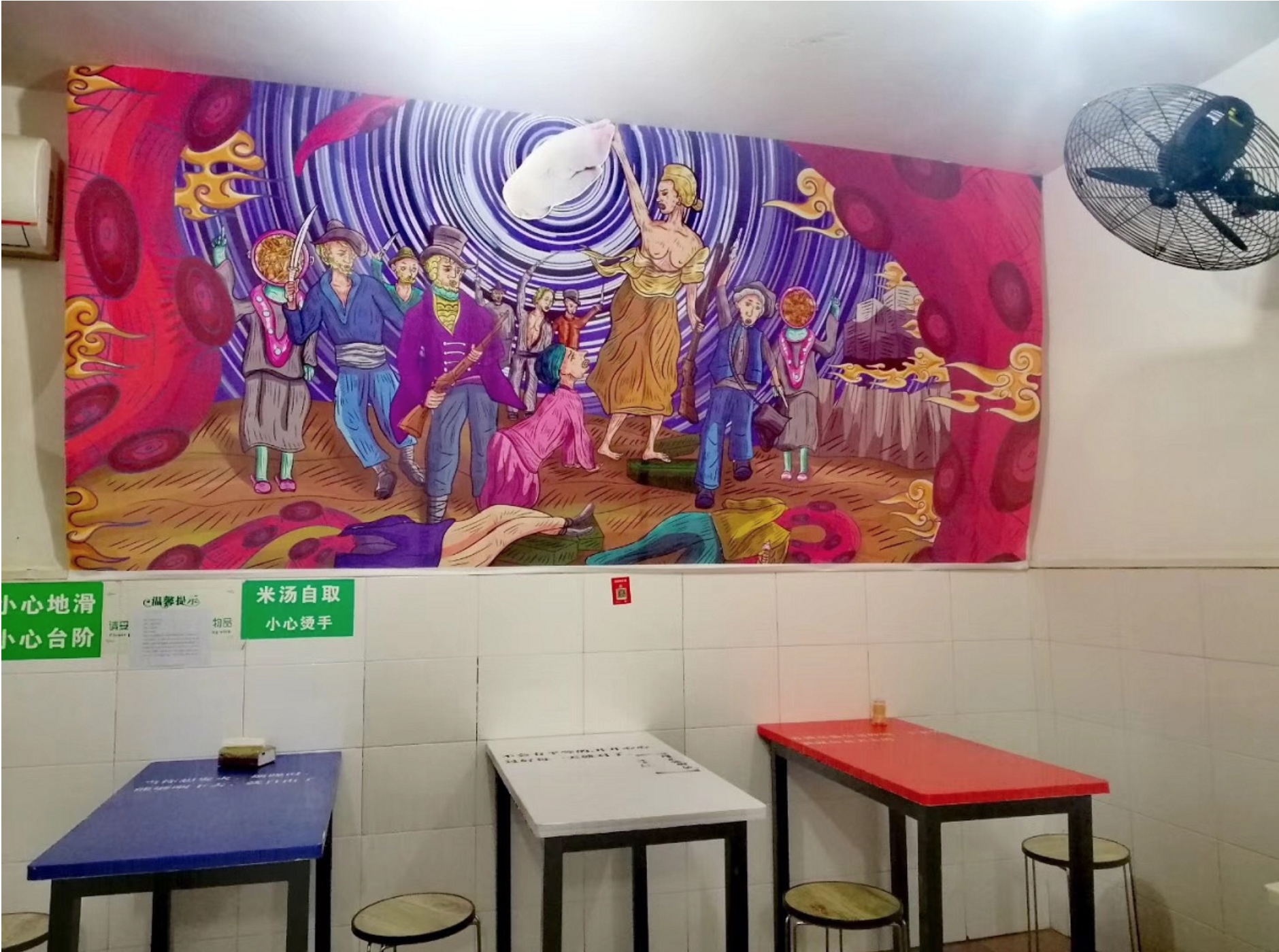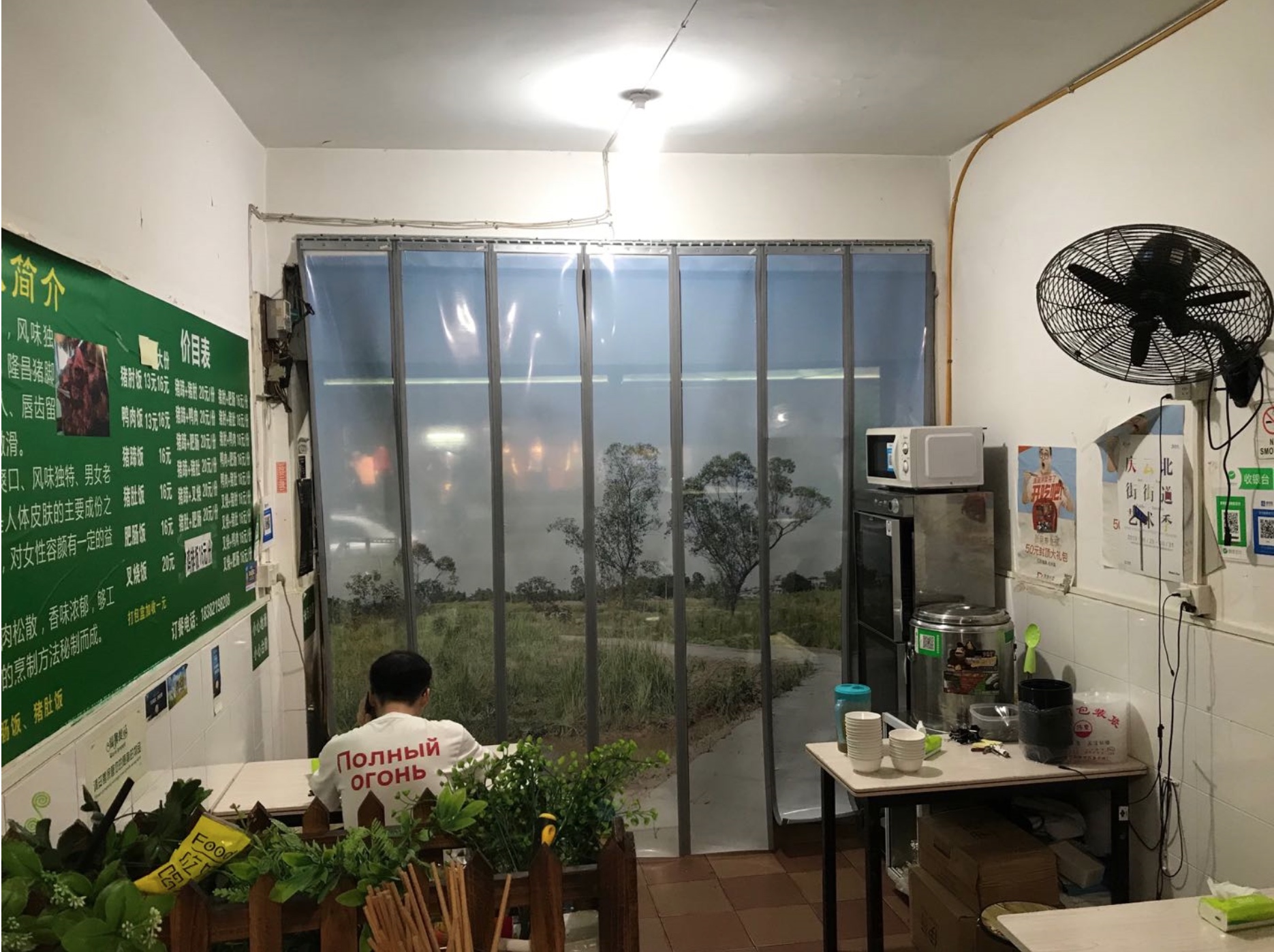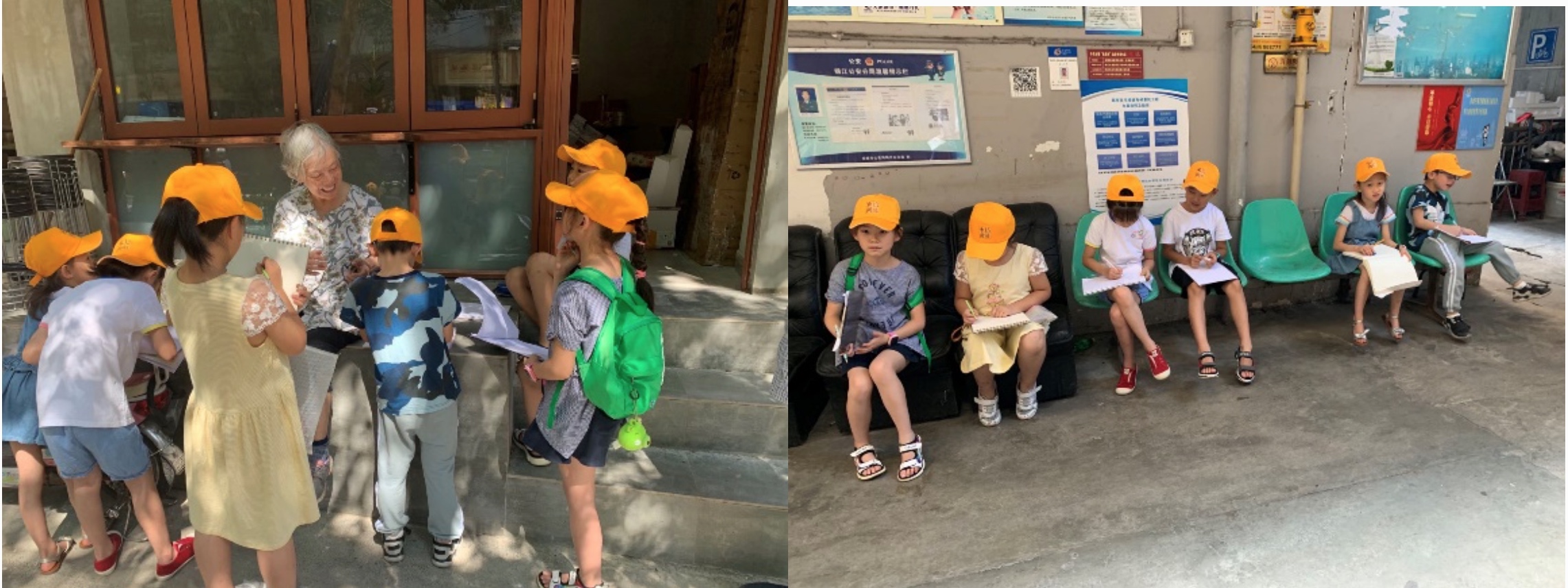Almost Four 肆空间 in Chengdu is a family-run tailor shop turned artist-run space & residency, initiating and engaging in neighborhood projects. We caught up with them about working in a tiny space (not quite, but almost 4 square meters) and running a café to keep their storefront space running on a street of shops and restaurants.

Street view of Almost Four.
肆空间全景
China Residencies: Thank you so much for taking time to talk about Almost Four and the projects you do! Who is part of Almost Four, and what are your backgrounds?
Almost Four: The space Almost Four technically does not belong to us as individuals but to our artist group "Company Art Team," a project we have initiated as an artist collective a while ago. The team members of the ”Company“ Art Project “公司”艺术项目are us three: Huang Jiao, Xiang Zheng, and Ma Kun. It started out in 2015, where the three of us all took part in a week-long workshop at the A4 Art Museum in Chengdu. During the workshop, we started our first collective art project, and then continued working together as an artist collective. Xiang Zheng and Ma Kun are artists, Xiang Zheng's works with oil paintings and paper carvings. Ma Kun works as a contemporary calligrapher and ink painting. Huang Jiao is an independent curator for art projects, and mainly responsible for the projects’ organization and implementation.
China Residencies: When and how was Almost Four founded? And how did Almost Four get to its name?
Almost Four: We set up Almost Four at the beginning of 2018. It started all in 2017, when Xiang Zheng told us that the lease on his family’s store would run out soon, and they wanted someone to keep it going. The three of us then discussed the possibility of using this place as an art space. Everyone supported Xiang Zheng's decision to use part of the store as a space to develop art projects. So this is how this space came about: with a small kitchen on the left side of the space, where we sell snacks and local favorites like red bean buns, egg tarts, milk tea, and coffee, and on the right side, there's the independent art space, which size is almost four square meters -- hence the name Almost Four. The name "Almost Four" was actually given by the first Swedish artist Tosten Jurell who we invited to take part in an exhibition. Originally, our floorplan was four square meters, but during renovation, city management asked us to install the door on the inside, which resulted in the internal space being just a bit less than four square meters. Everyone liked the idea, and for the Chinese name, we used the traditional character of the number four 肆.
China Residencies: What kind of shop did Zheng’s family run there before?
Almost Four: It was a tailor shop, which ran for more than 10 years.
China Residencies: You are situated in a residential street that is still filled with the old neighborhood sounds and feels, really close to the city center. How does the location influence the way you run?
Almost Four: The main reason we are here is because the store passed down from Xiang Zheng’s family. We have no choice to go anywhere else, since no one has the money to rent a location with a larger space. Another reason we're drawn to this location is that the small space fits our desire to experiment artistically. With less than four square meters of space, the question of what kind of art can you do and display is a really interesting one. For us, artistic creation and project developments should not be restricted to the physical size of the space. Being in a small space in this neighborhood means that local interaction is really important to us. It always reminds us that art needs to deal with the real world, and to be able to face the present.


Company Art Project 1.0, 2015
《Company Art Project 1.0》部分作品,2015
China Residencies: Aside from Almost Four as an art space where you host exhibitions, you have also host resident artists and are running a small café running on one side of the space. Can you tell us a bit about these different aspects of Almost Four of why and how you decide to run all three projects at once?
Almost Four: We opened the café for a simple reason: to be able to have a steady flow of income. It is mainly a practical way to keep going. The kitchen/café space on the left side of Almost Four is named JU JIAN. When Zheng quit his job to start this art space, he taught himself to bake egg tarts, and make different coffee specialties and milk tea. The income from the café JU JIAN is now his main income. The free space on the right of Almost Four is used for art-related activities and exhibitions.
China Residencies: Can you tell us a bit about the artist residency projects?
Almost Four: Since we are paying for the operating costs of the storefront all by ourselves, we don’t have a lot of funding, so it's very hard to run a residency properly. Still, even if we cannot provide a very high amount of funding, we link the resident artist with local resources, be it with fellow artists or institutions. Until now, we had one German artist here with us for one month, Fabian Hammerl. We have been keeping in touch with other institutions and artists, hoping to carry out a residency program more regularly in the future. So, we very much welcome artists, scholars, curators and art workers to stay and work on projects. Everyone is welcome to send us an email to get in touch, and we can chat about what is possible.

Solo Exhibition “Waiting for the not-yet-arrived“, Li Jun, 2019
个展《未到来之人的等待》,李俊, 2019
China Residencies: What did the artist provide themselves, and what did you provide during the residency?
Almost Four: We provide an accommodation and a studio, and small amount of money to buy materials, daily life support such as a mobile sim card, a transportation card for bus and metro to get around in the city. We organize an artist talk or workshop in an academy or other institution, help to build local community connection, and assist in their artistic creation. For those who want to join the residency, they'll need to pay for their own transportation (international or domestic flight, train, bus), and a residency fee of RMB 4,000 per month to cover the costs.
China Residencies: When we visited Almost Four last summer, you told us about some of the projects you did with your neighbors. Can you tell us about a few of the projects you did in the neighborhood?
Almost Four: One of the larger projects working with the neighborhood and the stores next to Almost Four is the Qingyun-North-Street Art Festival, which happened in 2019. [Qingyun-North-Street is the name of the street where Almost Four is located]. For this, we invited the Chengdu-based artists Yin Xiaofeng, Nan Xi, Wang Yishan, Ma Kun & Liu Yingjun, Yang Ran, Xiang Zheng, He Liping, Li Aixiao, Wei Xiaojing and Guan Guan, the German artist Fabian Hammerl and Dutch artist Marco Osting. After an initial phase of talking to each store owners to get their permission, each artist worked in one shop, and displayed their final work in the window front there. We neither applied for an official permit nor notified the local government about this project -- rather went the personal route by approaching the stores one by one, and talking with the store owners directly. We did the same with the material fees and reimbursements for the artists. We also did not go through the formal route of publicizing it, we just posted the posters and flyers through Almost Four’s public Wechat account. In the end, the store owners who collaborated in this project were the ones who already knew us and our art space well, building on our long-standing good relations.
All together, the Qingyun-North-Street Art Festival was a four part project. The artists’ projects was one part, we also hosted children’s art projects, open-street workshops, and hosted public activities. We also decided to not set an opening or closing date. Rather, participating artists could decide on their own and work on their own pace during this festival. It really was a grassroots festival, as opposed to big events built up on formal grounds. The total time from the concept and development to the final implementation took between 3 to 4 months. Of course, we experienced a lot of twists and turns during these months. Conflicts of interests emerge when wanting to plan a public street festival. Some issues came from the blurring boundaries between the "art scene“ and public space, or frictions between the curated academic framework of some projects and their actual artistic execution. In some cases, the artist lost their inspiration at the physical location of a store or restaurant. In other cases, the shop owners wanted to receive a stipend or money for participating in this festival. All these issues were either interpersonal, or stemmed from frictions between individuals and institutions, and all of these issues were revealed during this process.
Despite these points of friction, the final works which emerged were very interesting. One included the work of Yin Xiaofeng, titled “21 Qingyun North Street“. The artist plastered the floor of Almost Four with relics of pottery pieces from different time periods on the floor, which were found from local archaeological sites nearby.

"21 Qingyun North Street", Yin Xiaofeng, fragments of ancient ceramics.
《庆云北街21号》,尹晓峰,古陶瓷残片
Yang Ran invited strangers to share a meal at the Qingyun restaurant for their work “Don’t speak while eating." It was located outside of a restaurant. During the meal, everybody was instructed to stay silent and not to play on their phones. A lot of residents and neighbors stood around their table, watching the performative work.

Don’t speak while eating, Yang Ran
《食不言》,杨然
Artists Ma Kun and Liu Yingjun re-painted Delacroix's classic oil painting "La Liberté guidant le peuple" into quite a different version. They replaced the banner in the painting with a gigantic pig foot, changing the title of the work to "Food is Everything for the People."

"Food is Everything for the People", Ma Kun + Liu Yingjun
《民以食为天》,马锟+刘英俊
The owner of the Qingyun restaurant, his nickname is "Pang Ge", is also an avid fan and collector of folk pottery. After meeting and and learning about his story, the artist Nan Xi made a piece of personalized folk ceramic with the store owner on it. Wang Yishan set up a small table in front of the noodle shop in our street and invited passerby's to join him for a bowl of noodles in return for a conversation and a picture. Fabian Hammerl, the German artist, paired up with an owner of a shop selling braised pig trotters. He went to the shop owner's hometown and returned with photos of the surrounding scenery.

Distributed landscape, Fabian Hammerl
《星罗棋布的风景》,Fabian Hammerl
After asking the shop owner to pick his favorite, he then printed the photograph on one of those large, half-transparent plastic curtains used to keep the cold air-conditioned air inside. When sitting inside the restaurant and looking towards the street, the home scenery overlaps with the street view, forming a portal of space and time.
There were also other public events: “Look for the beauty of Qingyun North Street” and "Panorama of Qingyun North Street" was a children's art project; an artist talk in next door dessert shop, an outdoor artist workshop which was supported by the German Consulate General in Chengdu, and diverse flash art-and-coffee activities and concerts on the streets. We found that these projects were really welcomed by the neighbors, and a lot of residents took part.

At the start, the original reason for starting this street festival was because our space was facing the same issues of operating a commercial space as all the other spaces and shops on this street. But at the same time, we are also an art space. This led us to think about how art functions. What does art have to do with the people in our neighborhood? By being outside the context of an artist studio or artist villages, and being embedded in the daily life of a local neighborhood, we asked ourselves if there was the possibility to grow art projects. And if yes, what does the space look like? How do artists work outside of their studios, in public? When faced with reality, we need to re-think the creative process, starting from the very ideas we have about a work of art to the actual physical manifestation of an artwork. It's especially important to question if it is possible to solve real-world issues while still thinking in a conceptual way about art itself. What is the best way to open up such a conversation in this field? And how do we start a dialogue with the people living around us? How can art really function in real life? Although the street festival is over, we would like to continue thinking about these questions in relation to our space, and hope that it might continue to urge us to think about it.


Woodcut print public workshop.
木刻版画作坊。
China Residencies: What exactly is the "Company Art Project“ behind Almost Four?
Almost Four: At the beginning, we thought about the space as a bridge to provide artists a street-side window where they could create. In 2018, we hosted four exhibitions. In 2019, we hosted one artist resident, one exhibition, a street festival, and public events. The usual format we work in is exhibitions, projects, and public activities. On one hand, we hope that more artists can use this space for experimental creation. On the other hand, we welcome artists to explore the local life and issues the residents care about in this community and the neighborhood through this space.
Many of the "Company Art Project's" own creations involve collaboration. For example, in 2015, in the first project titled "Company Art Project 1.0", we worked with American artist Shannon to build a small station on some vacant land next to the Chengdu Sunshine New Industry Center, a district in Chengdu. Volunteers collected characters from the audience which were negatively viewed or felt by the audience. Then we assembled a "production line", similar to Ford's production line. We then one by one "processed" these words into something else, which was completely different from the initial characters. In an afternoon of 4 hours, we "processed" around 100 works [the results can be seen in the four small photos at the beginning of the interview]. For the 2016 "Grandma Kitchen" project, we invited young people to make home-cooked meals and snacks for the elderly living in the community. The barriers link different groups of people.
The 2018 project "Pour Out Your Heart" was commissioned by the A4 Art Museum. We interviewed more than 100 mothers and collected their feelings about womanhood in general, and as mothers, wives, and daughters. The main issues that arose were the conflicting and contradictory views of switching between their own social identity and their role in family relationships. We extracted some key information from the survey, and composed lyrics out of them and invited Chengdu rappers to sing, and finally presented in the form of music videos for the songs. In 2019, the "Huang Bian Tea Party" is the work we created for the "Creating and Painting the Future" Community Art Festival at the Guangdong Times Museum. We visited the people living in Huangbian Village, Guangdong, and held the Guangdong and Sichuan “Huang Bian Tea Party. Through organizing this event, we wanted to help the local community to figure out how they can open up and adapt to external environmental and cultural changes, which do affect them very much. When working on creations, we hope that through a specific and subtle point of access, we can start a more multiple-dimensional discussion of the interrelationships between individuals and groups and the real problems and contradictions of the internal and external worlds hidden or projected behind them.
China Residencies: How have the past few months been for you all? Are you all located in Chengdu at the moment, or somewhere else?
Everybody: Everyone has been home.
Xiang Zheng: I was at home in Chengdu, mainly taking care of my baby.
Ma Kun: I have been staying in Dujiangyan for the past few months, my only movements were a straight line between my home and studio, every single day. I usually spend my mornings with the two little ones. We would watch the news together, or play inside. When they are down for their nap in the afternoon, I bike or walk to my studio.
Huang Jiao: I went back to my hometown to spend the Spring Festival with my parents and bought my cat with me. When I returned to Chengdu with my cat afterwards, my schedule looked something like this: staying at home, mostly sleeping, eating, and playing with the cat. Generally, I just had very little energy to do things. I bought a bunch of books online but could not concentrate on reading them. A while ago, I started going out for runs at night.
China Residencies: How has the pandemic impacted your daily life, and how did it feel to stay inside for so long?
Huang Jiao: The current pandemic had a huge impact on everybody. For me, it made me look closer at the value of life and also reflect on the value of art. Aside from psychological and spiritual ruminations, our financial income has came to a halt. As a result, we even switched to cheaper cat food at home. It feels a bit like going back to the planned economy. My main thought recently have been about ways to make money, to work towards re-opening, and new art projects.
Ma Kun: My emotions during the pandemic oscillated between being anxious and overwhelmed. Now, I've entered a stage of calmness. For me, I see this pandemic does hugely influence our way of life, but cannot control how we adapt, our ways of reflecting and dealing with things.
Xiang Zheng: The impact has been quite deep, up until now. It is still unthinkable to open our doors in such early stage. Because we cannot open the café for business, we don’t have the income we had before. Lots of regular customers were nearby office workers, so they would not be coming in now even, if we were open, so for me the impact on our income has been huge.
China Residencies: This is tough to hear. The crisis has made it so hard for people worldwide, and we've been hearing that a lot of creative spaces are struggling. Art workers has often been forced to live precariously, and nowadays it is definitively a lot harder to keep on. How will your next few months look like and how do you see the future?
Almost Four: We are waiting for the complete end of the pandemic. Once it's over, we are planning to resume our activities in our art space. Last year, we have been keeping in touch with some art organizations in Cologne and Berlin, and are looking forward to future projects with them.
China Residencies: Are there any other things you want to talk about?
Almost Four: The thing we are working on right now is to combine all the projects we have done into a small manual or booklet. Also, we are slowly updating our website. But still, everything is going a bit slow.
China Residencies: Very understandable. It can be very hard to focus on things, and it is now the time to first take care of yourselves. Wishing you all the best moving forward!

Solo exhibition "Landmarks of the Nether", Tosten Jurell (SE), 2018
个展 《幽冥的地标》,Tosten Jurell(瑞典),2018
中国艺术交流:非常感谢你们抽空来聊聊肆空间!肆空间的成员都有哪些呢?可以介绍下自己,和各自的背景吗?
肆空间:其实肆空间属于我们“公司”艺术小组做的一个项目。 小组成员包括黄佼、向征、马锟三个人。2015年大家机缘巧合一起参加了A4艺术中心的七天工作坊,以小组的形式做了第一个艺术项目,之后就以艺术小组进行创作。向征和马锟是艺术家,向征的创作包括油画和纸雕, 马锟是当代书法和当代水墨,黄佼是独立的艺术项目统筹,主要负责项目的组织实施等具体工作。
中国艺术交流:肆空间是什么时候以及如何成立的呢?可以给我们介绍肆空间的情况,以及这个名字来历的故事吗?
肆空间:肆空间是在2018年初成立的。 在这之前2017年的时候,向征说他们家的铺面租约到期后想收回来自己做点什么,然后我们小组3个人就讨论了拿这个地方做一个艺术空间的可能性。大家都支持向征将店铺划一部分作为开展艺术项目的空间。所以就有了现在的左边是厨房,日常经营本地小吃蛋烘糕,奶茶,咖啡,右边就是不到四平方的独立艺术空间肆空间。 肆空间这个名字其实是第一个受邀参加我们展览的瑞典艺术家给取的。本来我们空间规划有四个平方,但是装修的时候城管要求我们把门安装在里面, 这样内部空间就少于四个平方了。 瑞典艺术家听说之后,建议说,干脆叫Almost Four作为英文名吧。于是大家都赞同,中文用的大写的肆, 就是这样来的。
中国艺术交流:之前的商店是什么商店?
肆空间:肆空间改造之前是一间裁缝店,开了有十多年了。
中国艺术交流:你们位于离市中心很近的安静的住宅街区,为什么会选择这个地方,在离街坊和日常社交生活距离如此近的地方对你们来说有多重要呢?
肆空间:一方面,因为这个店铺是向征家里的,我们也没得选,大家都没有钱去租更大的空间。另外一方面,这个小空间反而满足了我们想要尝试用不同方式去进行艺术创作的愿望。不到四个平方的空间,到底可以做什么样的艺术,是个有意思的问题。对我们来说,艺术创作和项目开展不应该被物理空间所限制。这样的市井环境和空间对我们很重要,它时刻提醒着我们艺术需要面对真实的外部世界,以及活在当下。
中国艺术交流:肆空间除了作为艺术空间做展览之外,你们也有接待驻留的艺术家,以及在空间旁边有小的咖啡区,可以聊一下关于肆空间这些不同的方面吗?
肆空间:这个比较简单,主要从功能上考虑,左边的厨房名字叫JU JIAN,主要是向征辞职了专门来做这个,他自学烤蛋烘糕,做咖啡和奶茶, JU JIAN的收入就是他主要的生活来源。右边的肆空间就是用来做艺术展览相关活动的。
中国艺术交流:关于驻留的项目具体是怎样的呢?
肆空间:驻留项目是我们的空间规划内容之一,但因为肆空间的运营费用是我们三个人自己掏腰包,在经费使用上还是比较拮据。我们虽然无法提供更豪华的物质支持,但在资源链接这些方面有一定的优势。到目前为止有一位德国艺术家驻留过1个月。 我们也一直有与其他机构和艺术家保持联系和沟通,希望以后可以定期开展。我们非常欢迎艺术家,学者,策展人,等来肆空间驻留或开展项目。欢迎大家与我们邮件联系咨询驻留的具体内容。
中国艺术交流:艺术家当时是提供了什么,肆空间提供了什么?
肆空间:我们安排住宿和工作室,提供部分资金来购买艺术创作材料,并提供手机SIM卡,城市内公交和地铁交通卡等日常生活支持,在学院或其他机构组织艺术家讲座或工作坊,帮助建立社区联系,并协助艺术创作。 对于那些想加入驻留项目的人,他们需要支付交通费(国际或国内飞机,火车,公共汽车),以及月驻留费4000元。欢迎大家与我们邮件联系获得更详细的内容。
中国艺术交流:去年夏天我们来拜访了肆空间,你给我们介绍了肆空间及规划的艺术项目,包括跟当地的居民们和社区安于项目。请问能介绍一下吗?
肆空间:肆空间做的有社区参与的项目,比较大的就是去年2019庆云北街街头艺术季了。当时我们邀请了几位成都艺术家和德国艺术家Fabian Hammerl,以及荷兰艺术家Marco Osting。成都艺术家参加的事尹晓峰,南希,王一山,马锟+刘英俊,杨然,向征,魏晓静,罐罐。经过与街道上的几个店铺沟通, 获得店主允许后,艺术家进入店铺中进行创作,最后作品在店内呈现。我们事先没有与社区政府沟通,全部靠自己去跟店铺一家家的谈,艺术家的创作费用也是各自解决的。也没有花大力气宣传,只是通过我们的微信公众号进行介绍。 最后支持并参与合作的店铺,也是相对比较熟悉,关系比较好的几家。除了艺术家创作的部分, 还包括儿童艺术,街头工作坊,公众活动,一共四个板块。艺术季没有开幕式也没有闭幕式,是以艺术家随机进入现场创作的方式,去贯穿整个艺术季。 整个项目立足草根,从构思,开展,到落地,经历3-4个月,中间一波三折。在市井中开展艺术项目,有很多不可预知的问题。包括艺术现场边界的模糊, 策展的学术框架与艺术实践之间的矛盾,又或是店家老板要求给钱才可合作,艺术家到现场没有灵感最后放弃,等等问题,都在人与人,人与空间之间的关系摩擦中被呈现出来。

Qingyun Meal, Nan Xi, Ceramic Painting
《庆云餐》,南希,陶瓷绘画
幸运的是,最后呈现的作品都很有趣,比如艺术家尹晓峰的《庆云北街21号》将曾经本地考古现场挖掘出来的不同时期的古代陶器残片铺在肆空间地面,以沉默的方式暗示此地的文化遗物;艺术家杨然召集陌生人在庆云餐门口吃饭的行为作品《食不言》,大家坐一桌全程禁止说话玩手机,引起了街区居民的围观;艺术家马锟和刘英俊重新绘制了德拉克罗瓦的经典油画《自由引导人民》,并将画中的旗帜改成一只巨大的猪蹄,取名为《民以食为天》,挂在店内;庆云餐老板胖哥同时是一位民窑陶瓷收藏家,艺术家南希了解了胖哥的故事后,为他特制了一张陶瓷肖像绘画;艺术家王一山在面对面面店门口连续摆摊三天,邀请路人吃面,交换条件是对方与他聊天并拍照;德国艺术家法比安专门跑了一趟猪脚饭老板的老家去拍照,回来后请老板选了一张他最喜欢的照片,打印并贴在透明的空调门帘里面,从店内望向门外,门帘上的家乡景色与门外的街景进行了时空的重叠...同时其他各个板块开展的活动,如儿童参与的庆云北街寻美活动,以及绘制的《庆云北街全景图》,由德国驻成都总领事馆支持主办的艺术家街头工作坊,公众活动部分的咖啡快闪,以及街头音乐会等,都获得很多居民的支持和参与。
其实我们一开始想做这个项目,也是因为肆空间与这条街上其他所有店一样,要共同面对和解决街区的商业经营问题。同时我们又在做艺术,我们想了解的是,街区上的人们是如何看待艺术?在这个普通又嘈杂的生活场景中,艺术生长的可能性在哪里,空间有多大?艺术的公共性在公共空间中如何体现?艺术家在工作室之外的创作要如何才会被触发?在面对真实世界时,创作从构想到落地,要如何在解决现实问题的同时保持艺术自身内在的思考?我们要用哪种方式,去开启与这个场域,以及在场域中生活的人的对话?在这个场域中,艺术到底可以作用于何方?等等。 虽然艺术季结束了,但这些问题将会伴随着肆空间一直存在,并不断督促着我们进行思考和创作。
中国艺术交流:可以给我们介绍下肆空间的项目和公司艺术小组?
肆空间:刚开始,我们把肆空间看做一个桥接的平台,给艺术家提供一个创作的窗口。2018年我们做了4个展览,2019年做了1个艺术家驻留项目,1个展览,一个街道艺术季,一个街头活动。基本形式是以展览,项目,和街头活动为主。一方面我们希望有更多的艺术家可以利用这个空间进行实验性的创作,另一方面,我们很欢迎艺术家通过肆空间这个窗口对居民,社区,街头这些本地化的议题进行探讨。

"Grandma's Kitchen", 2016
《奶奶的厨房》艺术项目,2016

Pour Out Your Heart, 2018
《听妈妈的话》 艺术项目,2018

Huang Bian Tea Party, 2019
《茶话黄边》艺术项目,2019
“公司”艺术小组自己的创作,有很多是他人参与和互动的。比如2015年第一个项目《Company Art Project 1.0》, 我们与美国艺术家Shannon合作,在成都阳光新业中心门口的空地上搭了一个帐篷,志愿者现场收集引发观众负面情绪的文字,我们用工厂流水线操作的现场创作方式,对这些文字进行处理,最后获得与原素材完全不同的艺术呈现方式。当天下午4个小时,我们做了大约100份作品;在2016年《奶奶厨房》项目中,我们邀请年轻人为居住在社区的老年人做家常菜、小吃,年轻人与老年人聊天,通过食物打破隔阂链接不同的人群;2018年的项目《Pour Out Your Heart听妈妈的话》,受A4美术馆委托创作,我们采访了100多位妈妈,收集了她们对于女性的自我价值在母亲、妻子、女儿这些社会身份和家庭关系中进行切换时的冲突和矛盾的看法,从调查中我们提取了一些关键信息,并作词谱曲,邀请成都的说唱歌手来演唱,最终以MV歌曲的方式呈现;2019年的《茶话黄边》,是我们为广东时代美术馆的“创绘未来”社区艺术节中创作的作品。我们走访了广东黄边村的原住民,通过举办粤川两地的美食交流茶话会,来探讨面对外部环境变化和文化冲击时的向心式宗族文化和原住民群体的开放和改变的可能性。在创作中,我们希望通过某个具体细微的切入点,去展开对个体及群体间相互关系以及其背后所隐含或投射的内外部世界的现实问题和矛盾点的更加立体的讨论。
中国艺术交流:过去的这几个月你们过得怎么样?这段时间你们都在成都还是其他地方呢?
大家:这段时间大家都呆在家里面。
向征:家在成都,主要在家带娃;
马锟:这几个月都呆在都江堰,每天家与工作室两点一线。上午和俩小子逗玩,一起看新闻,一起组装玩具。下午,他们睡午觉后,就骑车或者走路到工作室里;
黄佼:带猫回老家与父母过春节,年后回成都,一直在家,主要是睡觉,吃东西,逗猫,比较不思进取。网购了一堆书但是看不下去,后来慢慢的开始晚上出门跑步。
中国艺术交流:你们对这段时间有什么感受呢,对你们在成都的生活有什么样的影响?
黄佼:影响很大。疫情让我直视生命和思考艺术的价值。除开心理和精神上的,现在手上的业务全停了。家里的猫也跟着换便宜的猫粮了。感觉回到了计划经济。最近在想办法开展新项目赚钱。
马锟:对于疫情的影响,从焦虑到无所适从再归于平静的过程。因为,疫情可以改变我的工作、生活模式,但不会改变的是反思和自省。
向征:影响还是挺大的,因为疫情,前期肯定是不能开门的,目前即使开门营业也没有发生前那样的营业节奏,容易被很多事情打乱,周围上班族人群也渐渐带起了便当,所以对我来说生意影响还是蛮大的…
中国艺术交流:接下来准备做什么,以及对未来有什么期待?
肆空间:等疫情完全结束,我们会逐步恢复肆空间的项目计划。去年有与德国科隆和柏林的艺术家组织进行沟通,期待以后进行交换项目。
中国艺术交流:有其他项目或事情想要给大家分享下吗?
肆空间:目前计划把肆空间的项目整理成手册。还有我们的网站也在缓慢更新中。比较慢。
中国艺术交流:祝你们一切顺利!
This interview was conducted in Chinese and translated to English by Xiaoyao Xu for China Residencies in May 2020.
With the current pandemic and the ongoing travel restrictions worldwide, people have been finding ways to keep in touch with artists and friends online, since they can't meet up in person. In lieu of our annual research trip, we are revisiting spaces we've met in the past seven years through in depth interviews over WeChat until we can meet again.
